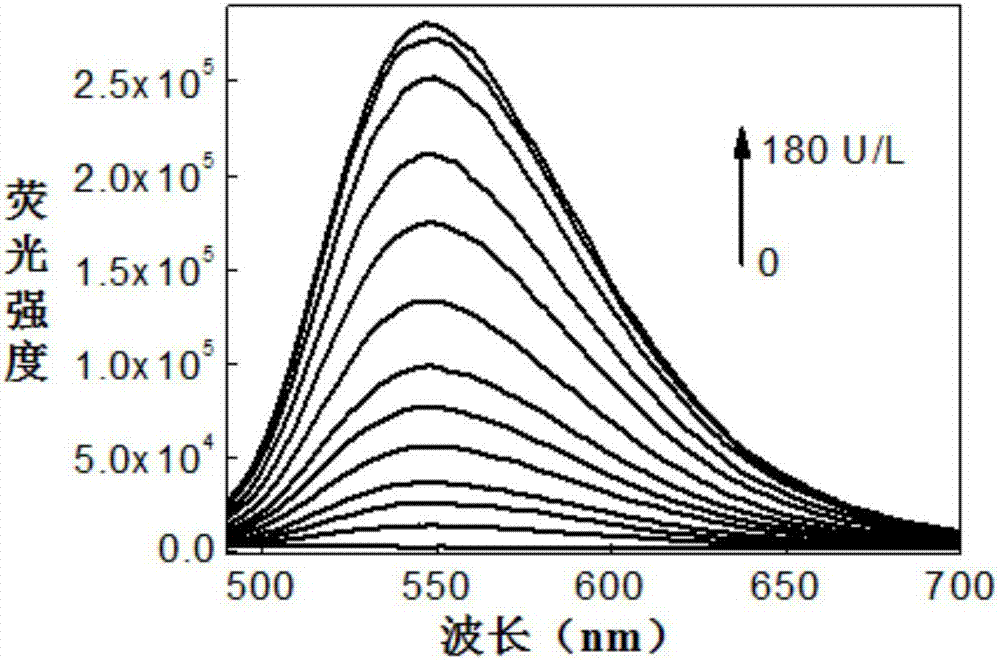Precipitated alkaline phosphatase fluorescence probe, and synthetic method and applications thereof
A fluorescent probe and synthesis method technology, applied in the field of fluorescent probes, can solve the problems of poor fluorescence imaging effect and easy diffusion of fluorescent probe signals, and achieve the effects of fast response, good dyeing effect, and simple synthesis method
- Summary
- Abstract
- Description
- Claims
- Application Information
AI Technical Summary
Problems solved by technology
Method used
Image
Examples
Embodiment 1
[0036] Example 1 Synthesis of Precipitated Alkaline Phosphatase Fluorescent Probe HTPQA
[0037] (1) 4-Hydroxy-tetraphenylethylene (3.482g) and urotropine (2.102g) were dissolved in glacial acetic acid (50mL), heated under reflux for 3h, dichloromethane and petroleum ether were eluents (two The volume ratio of methyl chloride and petroleum ether is 1:5) to obtain a light yellow intermediate (1.316g, 35%) through column separation;
[0038] (2) Reflux and stir the light yellow intermediate (0.3761g), 2-amino-5-chlorobenzamide (0.2050g) and p-toluenesulfonic acid (10mg) in absolute ethanol for 5h, add dichlorodi Cyanobenzoquinone (0.5g), suction filtration obtains yellow solid, washes solid with ethanol, dries to obtain pure yellow compound (0.43g, 81.5%), i.e. novel solid-state fluorescent dye i.e. 6-chloro-2-( 2-Hydroxy-5-(1,2,2-triphenylethenyl)phenyl)-4(3hydro)-quinazolinone, named HTPQ;
[0039] Mass Spectrometry and NMR Characterization of HTPQ:
[0040] 1 HNMR(DMSO-d6...
Embodiment 2
[0048] Embodiment 2HTPQA probe is to the detection of alkaline phosphatase in test tube
[0049] The HTPQA probe was made into 1 mM DMSO stock solution and stored at -20°C. The detection system is TBS buffer solution (10 mM, pH 8.0, containing 5% DMSO). The reaction system of HTPQA probe and alkaline phosphatase was shaken at 37° C. for 30 minutes, and then its fluorescence emission spectrum was measured. The excitation wavelength of the fluorescence instrument is set to 410 nm, and the emission wavelength receiving range is 500-700 nm. The result is as figure 2 shown, from figure 2 It can be seen that the HTPQA probe has a good response to alkaline phosphatase.
Embodiment 3
[0050] The reaction kinetic investigation of embodiment 3HTPQA probe and alkaline phosphatase
[0051] The reaction system is TBS buffer solution (10 mM, pH 8.0, containing 5% DMSO). The fluorescence emission spectra of the HTPQA probe and alkaline phosphatase with different activities were measured every 2 minutes at 37 °C until the fluorescence intensity no longer changed. Then take the intensity of the maximum emission peak as the ordinate, and the reaction time as the abscissa to make a graph, as image 3 The reaction kinetic curve shown, from image 3 It can be seen that the HTPQA probe responds rapidly to phosphatases. The excitation wavelength of the fluorescence instrument is set to 410 nm, and the emission wavelength receiving range is 500-700 nm.
PUM
 Login to View More
Login to View More Abstract
Description
Claims
Application Information
 Login to View More
Login to View More - R&D
- Intellectual Property
- Life Sciences
- Materials
- Tech Scout
- Unparalleled Data Quality
- Higher Quality Content
- 60% Fewer Hallucinations
Browse by: Latest US Patents, China's latest patents, Technical Efficacy Thesaurus, Application Domain, Technology Topic, Popular Technical Reports.
© 2025 PatSnap. All rights reserved.Legal|Privacy policy|Modern Slavery Act Transparency Statement|Sitemap|About US| Contact US: help@patsnap.com



